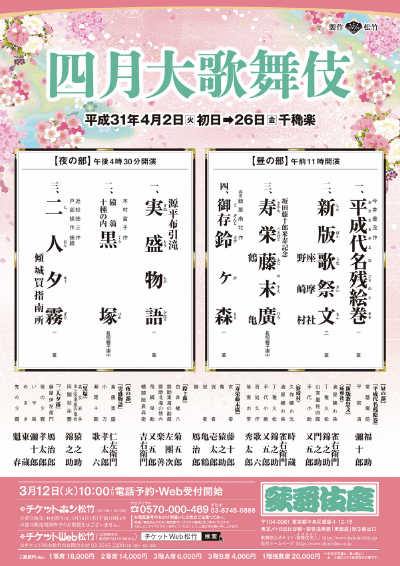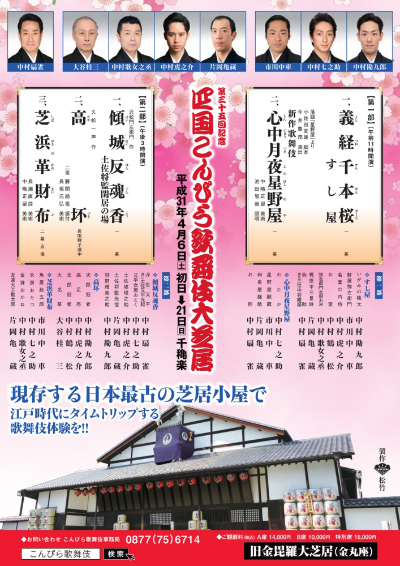| APRIL 2019 |
|
3 shows in T˘ky˘ (Kabukiza, Makuhari Messe), 2 shows in Nagoya (Misonoza), 2 on Shikoku island (Kanamaruza) and 3 tours (Classics Tour, Central Provinces, Zenshinza)!
|
| Kabukiza (T˘ky˘) |  |
| Dates | 2 ~ 26 April 2019 Shigatsu ďkabuki April Grand Kabuki |
| MatinÚe |
Osamaru Miyo Nagori no Emaki
Sakae Kotohogu Fuji no Suehiro |
| Evening |
Genpei Nunobiki no Taki Ninin Yűgiri |
| Casting |
Living National Treasure Sakata T˘jűr˘, Living National Treasure Onoe Kikugor˘, Living National Treasure Nakamura Kichiemon, Living National Treasure Kataoka Nizaemon, Living National Treasure Nakamura T˘z˘, Nakamura Jakuemon, Nakamura Tokiz˘, Nakamura Kaishun, Nakamura Fukusuke, Nakamura Ganjir˘, Kataoka Takatar˘, Ichikawa Ennosuke, Nakamura Kinnosuke, Kataoka Hidetar˘, Ichikawa Sadanji, Band˘ Yajűr˘, Nakamura Kazutar˘, Ichikawa Danz˘, Nakamura Karoku, Nakamura Matagor˘, Ichikawa Monnosuke, Nakamura Kikaku, Band˘ Rakuzen, Ichikawa Monnosuke, Kataoka Ichiz˘, Ichimura Kakitsu, Nakamura Kotar˘, Kawarasaki Gonjűr˘, Ichikawa Emisabur˘, Ichikawa Emiya, Ichikawa En'ya, Ichikawa Juen, Ichikawa Sai'nyű, Ichikawa Omez˘, Band˘ Minosuke, Kataoka Sennosuke, Nakamura Kash˘, Nakamura Yonekichi, Ichimura Takematsu, Nakamura Mantar˘, Nakamura Tanenosuke, Nakamura Takanosuke, Nakamura Jűjir˘, Kataoka Matsunosuke, Nakamura Kichinoj˘, Ichikawa Otora, Terajima Maholo |
| Comments |
5 Living National Treasures on stage, Onoe Kikugor˘, Nakamura Kichiemon, Sakata T˘jűr˘, Kataoka Nizaemon and Nakamura T˘z˘, for two April Grand Kabuki programs with the following highlights:
|
 |
| Misonoza (Nagoya) |  |
| Dates | 1 ~ 25 April 2019 Y˘shun Hanagata Kabuki Spring Sun Young Actors Kabuki |
| Program | |
| Casting |
Nakamura Shikan, Kataoka Ainosuke, Onoe Sh˘roku, Nakamura Baishi, Band˘ Shingo, Band˘ Kamez˘, Nakamura Matsue, Nakamura Hashinosuke, Nakamura Fukunosuke |
| Comments |
The return of the spring program at the Misonoza with young actors.
|
  |
| Kanamaruza (Konpira) |
| Dates | 6 ~ 21 April 2019 Shikoku Konpira Kabuki ďshibai Shikoku Konpira Kabuki Grand Theatre |
| MatinÚe | |
| Evening |
Keisei Hangonk˘ (Domo Mata) |
| Casting |
Nakamura Senjaku, Nakamura Kankur˘, Nakamura Shichinosuke, Ichikawa Chűsha, Kataoka Kamez˘, ďtani Keiz˘, Nakamura Kamenoj˘, Nakamura Toranosuke, Nakamura Tsurumatsu |
| Comments |
35th edition of the Spring Kabuki performance Shikoku Konpira Kabuki ďshibai at the Kanamaruza on Shikoku Island!
|
 |
| Kabuki Tour in the central provinces | |
| Dates | 31 March ~ 25 April 2019 Sh˘chiku ďkabuki Sh˘chiku Grand Kabuki |
| Program |
|
| Casting |
Matsumoto Haku˘, Matsumoto K˘shir˘, Nakamura Baigyoku, Ichikawa Komaz˘, Matsumoto Kingo, Sawamura S˘nosuke, ďtani Hirotar˘ |
| Comments |
The usual Grand Kabuki Tour in the central provinces, in April and not in July this year. Matsumoto Haku˘ II and his son Matsumoto K˘shir˘ X celebrate their shűmei.
|
 |
| Classics Tour | |
| Dates | 9 ~ 25 April 2019 Koten he no Izanai Invitation to the Classics |
| Program | |
| Casting | |
| Comments |
A special tour in 11 cities for the heir of the Naritaya guild. |
 |
| Makuhari Messe (Chiba) |
| Dates | 27 ~ 28 April 2019 Ch˘kabuki Ultra-Kabuki |
| Program | |
| Casting | |
| Comments |
The world of Kabuki and the world of otaku collide for the 4th time in Kabuki history! Resulting from this spectacular collision, a new genre, the Ch˘kabuki (literally Ultra-Kabuki), was born in 2016 [more details]. Nakamura Shid˘ shares the stage with the virtual 3D creature Hatsune Miku. They perform "together" in a newly-created Ch˘kabuki drama. It is staged at the Makuhari Messe as part of the Niconico Ch˘kaigi 2019 event, an important yearly event for the otaku tribes. |
 |
| Zenshinza Tour | |
| Dates | 13 March ~ 27 April 2019 |
| Program |
Ura Nagaya S˘d˘ki |
| Casting |
Kawarasaki Kunitar˘, Arashi Yoshisabur˘, Fujikawa Yanosuke, Matsunami Kihachir˘, Tadamura Shin'ya |
| Comments |
A March and April tour all over Japan for the Zenshinza troupe. "Ura Nagaya S˘d˘ki", which was written by the veteran movie director Yamada Y˘ji and was premiered in May 2017 at the National Theatre, is based on two famous rakugo stories, "Rakuda" and "Ido no Chawan". |
 |
|
|
| Contact | Main | Top | Updates | Actors | Plays | Playwrights | Programs | Links | FAQ | Glossary | Chronology | Illustrations | Prints | Characters | Derivatives | Theaters | Coming soon | News |